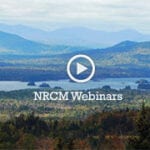Interior Department Must Declare Canada is Undermining International Wildlife Protections
News Release
Destructive mining and drilling practices in the heart of Canada’s boreal forest—a huge and important bird nursery—are putting millions of America’s migratory birds at risk and have already resulted in potentially hundreds of thousands of fatalities, according to an issue brief released today by the National Wildlife Federation and the Natural Resources Council of Maine. Among the imperiled birds is the majestic and critically endangered Whooping Crane, a much loved symbol of previous conservation success, which rebounded from a population low just 15 cranes in the 1940s to more than 600 today, thanks to intense efforts.
Now this species’ precarious comeback is at risk from tar sands expansion.
Birds we see here in Maine are among the species threatened by tar sands activity. Some of our most popular wintering waterbird species, such as White-winged Scoters, Surf Scoters, Buffleheads, and Red-necked Grebes, nest in and migrate over the tar sands region. Songbirds that migrate through Maine backyards in May, such as Blackpoll Warblers, Swainson’s Thrushes, and Yellow-rumped Warblers, also nest in and migrate through northern Alberta.
“Migrating birds don’t understand national boundaries and freely pass between Maine and Canada, leaving our nations and people with a shared responsibility,” said Lisa Pohlmann, Executive Director of the Natural Resources Council of Maine. “Tar sands mines and associated industrial development threatens the lands many birds rely on.”
The U.S. Department of Interior is under a legal obligation—known as the “Pelly Amendment”—to determine whether tar sands mining and drilling in Canada is undermining a century-old international treaty to protect North America’s shared songbirds and waterfowl. Tar sands are one of the world’s dirtiest energy sources. Not only do they have a significantly higher life-cycle emissions of climate-disrupting carbon pollution than conventional oil, but tar sands mining is destroying bird habitat and leaving behind massive tailings ponds.
“Unchecked tar sands development is turning a vast, irreplaceable breeding ground into a toxic wasteland,” said National Wildlife Federation Senior Counsel Jim Murphy. “Many of the birds Americans watch, enjoy, and hunt fly to and rely on this area. The Canadian Government has vowed to protect these birds, but it is turning a blind eye.”
As the report details, tar sands development sits in the heart of the previously pristine boreal forest, which provides important breeding habitat for birds. But now an area the size of Florida is being destroyed by huge open-pit mines, toxic waste tailings ponds that can be seen from space, extraction wells, noisy compressor stations, refineries, and networks of new roads, drilling pads, seismic lines, and pipelines.
Oil-laden tailings ponds have resulted in the deaths of countless waterfowl. In 2008, 1,600 ducks died in Syncrude tailings ponds. An October 2010 storm resulted in hundreds of ducks landing on a Suncor tailings pond near Fort McMurray; at least 550 birds were too oiled to save. As of 2010, 43 species of internationally protected birds had suffered fatalities from exposure to tar sands tailings ponds. Unabated tar sands development could result in the reduction of 70 million hatchlings over a 40-year period.
Of the 130 internationally protected American migratory and songbird species listed in the report as threatened by tar sands development, many are familiar names to birders, hunters, and wildlife enthusiasts in the United States, including Snow Goose, American Goldfinch, Evening Grosbeak, Great Blue Heron, Common Loon, Northern Pintail, Wood Duck, Pine Siskin, Trumpeter Swan, Cedar Waxwing, and the Pileated Woodpecker.
“Maine is fortunate in hosting an abundance of birds on migration and during winter that nest in the boreal forest region of Canada,” said Maine ornithologist Iain Stenhouse from the Biodiversity Research Institute. “Not only does tar sands development cause the loss and destruction of important breeding habitat for birds, the contaminants from tar sand operations can have serious and far-reaching consequences. The toxic tailings ponds actually attract migrating waterbirds, and mercury contamination has increased dramatically in vast areas surrounding these oil fields. We need to find ways to minimize the human impacts to bird populations, especially as they struggle to adapt to the effects of climate change—effects that are only exacerbated by carbon-based energy developments like the tar sands.”
“Wildlife and tar sands don’t mix,” said Murphy. “The Canadian Government is putting polluting fossil fuel profits above the welfare of birds and other species. Interior Secretary Jewell and the President can send a message to Canada that it is unacceptable to undermine our shared wildlife heritage. The President needs to act by rejecting dirty tar sands pipeline projects like Keystone XL. Moving forward with clean, wildlife-friendly energy, not tar sands, is the answer.”









